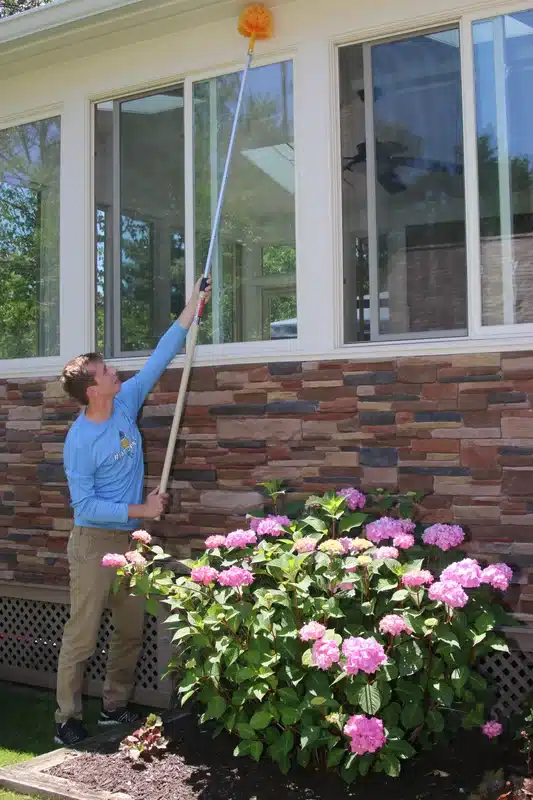If you’ve spotted large, fuzzy bees buzzing around your deck or garden in the DC area, you might be wondering what type of bee you’re dealing with. Understanding the difference between carpenter bees vs bumblebees is crucial for homeowners because these two species behave very differently around your home.
After four years as a registered technician in our family’s pest control business, I’ve seen plenty of confused homeowners who can’t tell these bees apart. While both are important pollinators, only one of them will bore holes into your wooden structures. The other prefers to nest underground and rarely causes any property damage.

In the Washington DC and Northern Virginia region, we primarily deal with the Eastern Carpenter Bee and several bumblebee species. Knowing which one you have helps determine whether you need treatment or can simply enjoy watching these pollinators work.
Quick Identification Guide: Carpenter Bees vs Bumblebees
The easiest way to distinguish between carpenter bees and bumblebees is to look at their abdomens. Carpenter bees have shiny, black, hairless abdomens that look almost metallic in sunlight. Their bodies are typically 3/4 to 1 inch long with bright yellow, fuzzy thorax areas.
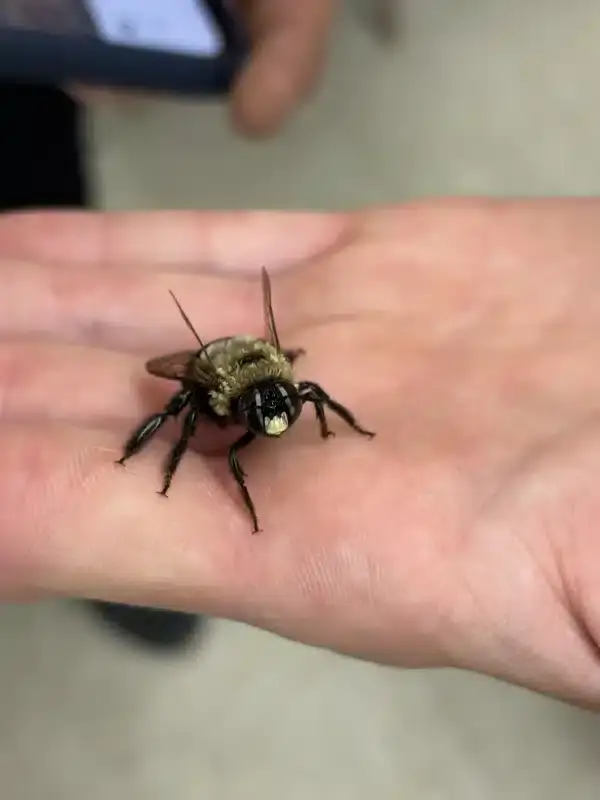
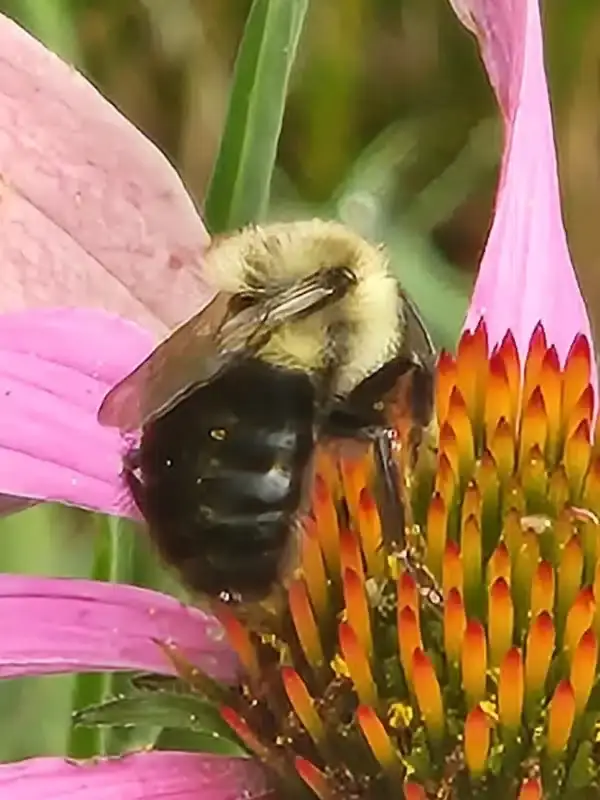
Bumblebees, on the other hand, are covered in dense hair with distinctive yellow and black bands across their entire bodies. They’re generally 1/2 to 1 inch long and have a more rounded, compact appearance. You’ll also notice pollen baskets on their hind legs when they’re foraging.
The DC Metro area hosts multiple bumblebee species, with the Common Eastern Bumble Bee being the most frequently spotted in suburban yards.
What does the science say?
According to the Virginia Tech Cooperative Extension, our region hosts about 14 different bumblebee species. Their research identifies the Common Eastern Bumble Bee (Bombus impatiens) as the most frequently spotted species in suburban yards, with additional species including the Brown-belted Bumble Bee and the Two-spotted Bumble Bee contributing to local pollination services.
| Characteristic | Carpenter Bee | Bumblebee |
|---|---|---|
| Abdomen | Shiny, black, hairless | Fuzzy with yellow bands |
| Nesting Location | Wood tunnels | Underground burrows |
| Social Behavior | Solitary | Social colonies |
| Wood Damage | High risk | Minimal risk |
| Sting Risk | Males can’t sting | Can sting when threatened |
| Treatment Need | Often necessary | Rarely needed |
Nesting Behaviors: Wood Borers vs Ground Dwellers
The biggest difference between carpenter bees vs bumblebees lies in where they choose to nest. This difference also determines which species might damage your home.
Carpenter Bee Nesting Patterns
Carpenter bees are solitary insects that excavate perfectly round, 1/2-inch holes in soft, unfinished wood. These bees prefer unpainted pine, cedar, and cypress - exactly the materials commonly used for deck railings, fascia boards, and porch trim.
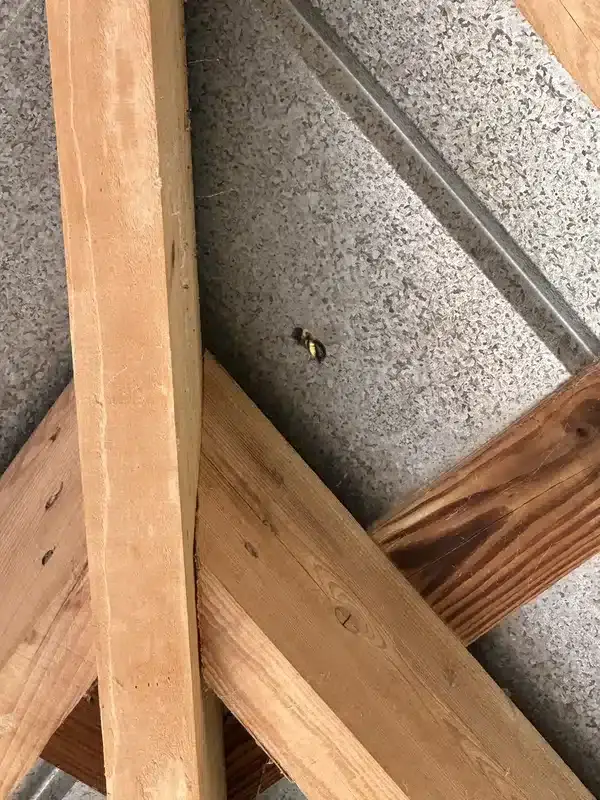
Once inside, females tunnel 6 to 10 inches horizontally along the wood grain, creating galleries divided into 6-8 brood cells. You’ll often find coarse yellow sawdust below these holes - a telltale sign of carpenter bee activity.
In our experience serving the DMV area for over 50 years, moisture and UV-weathered wood significantly increases the attractiveness of structures to carpenter bees. That’s why deck ends and fascia boards are such common targets.
Bumblebee Nesting Habits
Bumblebees are social insects that nest very differently from carpenter bees. About 80% of bumblebees nest in abandoned rodent burrows 6-12 inches underground, while the remaining 20% choose above-ground cavities like bird boxes or spaces under decks.
These ground nests rarely exceed the size of a softball and contain wax pots rather than honeycomb structures. Unlike carpenter bees, bumblebees don’t damage wood structures during nesting.
Structural Damage Assessment
When comparing carpenter bees vs bumblebees for potential home damage, there’s a clear winner in terms of destruction potential.
Carpenter Bee Damage Risks
Carpenter bee damage accumulates over time. Multiple females often reuse and expand existing galleries annually, potentially weakening thin fascia boards or deck rail caps. Water entry, fungal rot, and secondary woodpecker damage can significantly magnify the initial structural loss.
What does the science say?
The University of Maryland Extension research documents how carpenter bee damage compounds over time. Their studies show that initial 1/2-inch tunnels expand as females return to the same locations annually. The research emphasizes that secondary damage from water infiltration and fungal decay often exceeds the original tunneling damage, particularly in fascia boards and deck railings where moisture accumulation occurs.
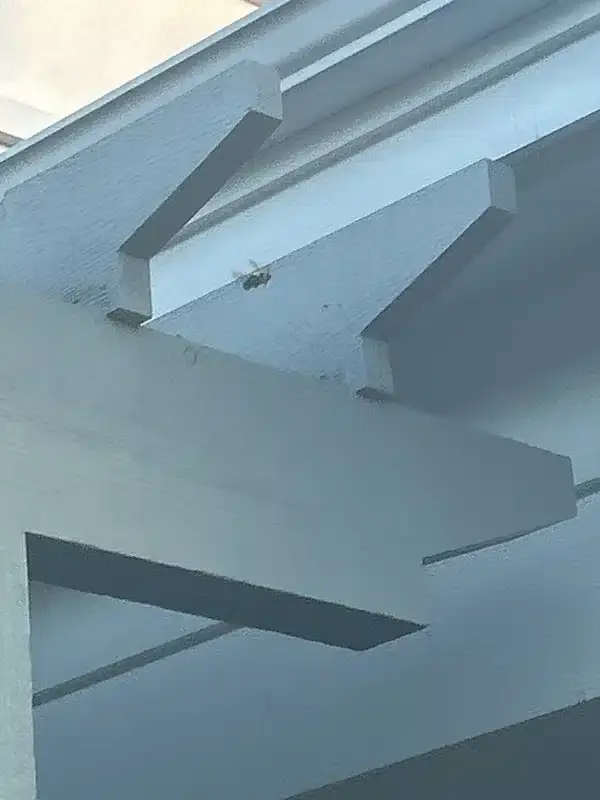
Load-bearing joists thicker than 1-1/2 inches typically tolerate moderate tunneling without structural issues. However, cosmetic damage often appears first as yellow excreta stains that develop into black mold streaks on the wood surface.
For more detailed information about identifying damage signs, check out our guide on carpenter bee damage and what those distinctive holes mean for your property.
Bumblebee Impact on Structures
Bumblebees cause virtually no structural damage to homes. Occasionally, ground nests beneath deck stairs might lead to defensive stinging when foot traffic creates vibrations, but physical damage to wood is negligible.
The main concern with bumblebee nests is human interaction. If a nest entrance is within 3 feet of a high-traffic doorway or play area, relocation might be necessary for household comfort.
When Carpenter Bee Damage Goes Unnoticed
During my four years as a registered technician, I encountered a particularly challenging case in Arlington where a homeowner called about “just a few small holes” in their deck railing. What we discovered illustrates why early identification matters.
- Initial complaint: Three visible holes in deck railing
- What we found: Fifteen active galleries throughout the deck structure
- Hidden damage: One railing post showed significant structural weakening
- Secondary issues: Woodpecker damage around several holes, creating larger openings
This experience reinforced why our family business emphasizes thorough inspections - what homeowners see is often just the beginning of carpenter bee activity.
Pollination Value: Both Species Matter
Despite their different nesting habits, both carpenter bees and bumblebees provide significant pollination services to DC area gardens and crops.
Buzz Pollination Specialists
Both species are buzz pollinators, meaning they vibrate their flight muscles to release tightly held pollen from flowers. This specialized technique is crucial for certain plant species.
What does the science say?
Research from the U.S. Forest Service explains that buzz pollination involves bees gripping flowers and contracting their flight muscles to vibrate at frequencies between 200-400 Hz. This technique dislodges pollen from flowers with poricidal anthers (like tomatoes and blueberries) that don’t release pollen through wind or casual contact. Without buzz pollinators, these crops would produce significantly fewer fruits.

Regional Pollination Impact
Bumblebees serve as workhorses for Mid-Atlantic tomato, blueberry, and pepper production. Research from the University of Maryland Extension shows that four or more buzz visits per tomato flower dramatically improve fruit weight and quality.
Carpenter bees contribute to pollination of passionfruit, eggplant, and early-morning flowering ornamentals. Approximately 15% of U.S. crops receive some pollination from native bees, including carpenter bees.
Seasonal Activity in the DC Metro Area
Understanding when carpenter bees vs bumblebees are most active helps homeowners plan appropriate responses.
Carpenter Bee Life Cycle
Carpenter bees have one generation per year in our region. Mating and gallery excavation occur from late March through May, coinciding with the blooming of willow and red maple trees. New adults emerge in late August and overwinter inside abandoned tunnels.
Bumblebee Colony Timeline
Bumblebee queens emerge from hibernation in late March as spring flowers begin blooming. Colonies grow throughout spring and summer, peaking at 50-500 individuals in July and August. The entire colony dies off in October, leaving only newly mated queens to overwinter.
How to Get Rid of Carpenter Bees vs Bumblebees: When Treatment is Needed
Not every bee sighting requires intervention. Here’s when treatment becomes necessary for carpenter bees vs bumblebees.
Carpenter Bee Treatment Thresholds
Consider treatment for carpenter bees when you notice:
- Multiple galleries in the same board over several years
- Structural sagging or splitting in affected timber
- Woodpecker damage from birds seeking carpenter bee larvae
- Significant cosmetic staining on valuable trim work
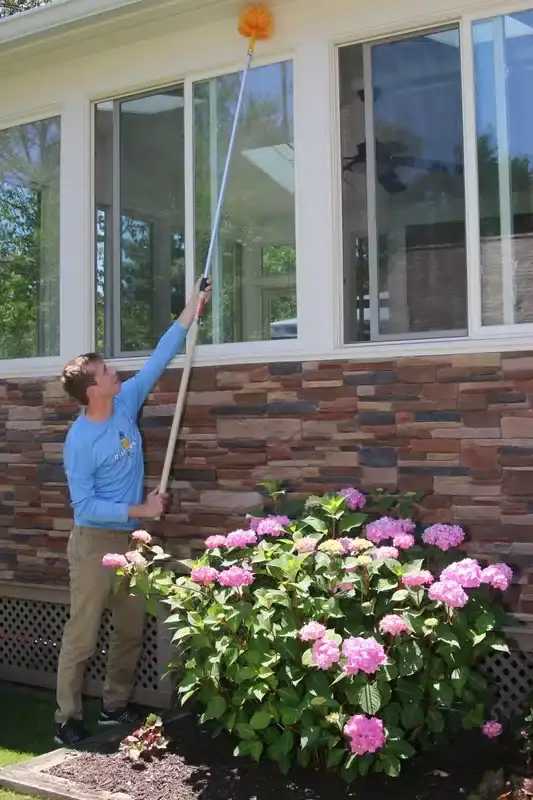
Our registered technicians recommend treating in early April before egg-laying begins or in late August after adult emergence. For comprehensive treatment options, review our guide on effective carpenter bee removal methods.
Bumblebee Management Approach
Bumblebees rarely require treatment due to their beneficial status and minimal structural impact. Consider intervention only when nests pose direct threats to people with bee allergies or are located in unavoidable high-traffic areas.
The Xerces Society recommends waiting until November to move soil or insulation near suspected nest sites to avoid harming overwintering queens.
Prevention Strategies for Both Species
Preventing problems with carpenter bees vs bumblebees requires different approaches based on their nesting preferences.
Carpenter Bee Prevention
The most effective prevention involves making wood surfaces less attractive:
- Paint or stain all exposed softwood surfaces before spring
- Fill nail holes and cracks in existing structures
- Replace severely damaged boards before they attract new females
- Consider hardwood alternatives for frequently targeted areas
Essential Carpenter Bee Prevention Steps
- Paint Protection: Apply quality exterior paint or stain to all exposed wood surfaces before March
- Timing Matters: Complete deck maintenance in winter when bees are dormant
- Wood Selection: Choose hardwoods like oak or maple for frequently targeted areas like railings
- Annual Inspection: Check fascia boards and deck ends each spring for new holes or sawdust piles
Bumblebee Considerations
Since bumblebees provide significant pollination benefits, focus on coexistence rather than exclusion:
- Maintain pollinator-friendly gardens away from high-traffic areas
- Install chicken-wire barriers if ground nests conflict with walkways
- Avoid disturbing soil near potential nesting sites during active season
Both species have different damage potentials, with carpenter bees posing the primary structural threat to homes while bumblebees focus on ground-level nesting.
Conservation and Legal Considerations
Both carpenter bees and bumblebees face conservation pressures in our region. The American Bumble Bee has experienced population declines exceeding 80% and is under review for federal listing due to habitat loss and pesticide exposure.
Many DC Metro municipalities have adopted “pollinator-friendly city” ordinances that protect native bees from indiscriminate destruction. These regulations encourage non-chemical management options whenever possible.
Our family business has adapted our approach over 50+ years of service, emphasizing targeted treatment only when structural damage or human health concerns justify intervention.
Carpenter Bee and Bumblebee Sting Risks
Understanding the sting potential of carpenter bees vs bumblebees helps homeowners assess true safety risks. Male carpenter bees cannot sting despite their aggressive hovering behavior around humans. The females can sting but rarely do unless directly handled or trapped.
Bumblebees can sting multiple times and are more likely to do so when defending their nest. However, they’re generally docile when foraging and only become defensive when their ground nests are disturbed by foot traffic or lawn equipment.
Professional Assessment and Treatment
When carpenter bees vs bumblebees become problematic, professional evaluation helps determine the most appropriate response. Our registered technicians conduct detailed inspections to identify species, assess damage potential, and recommend targeted solutions.
For carpenter bee issues, we focus on treating active galleries during optimal timing windows while providing prevention recommendations for long-term control. Bumblebee situations typically require education and coexistence strategies rather than chemical intervention.
If you’re dealing with either species around your DC or Northern Virginia home, our team can help you develop an appropriate management plan. We’ve removed 9 harsh chemicals common in our industry, choosing alternatives that respect both your family and beneficial pollinators. Call us at 703-683-2000 for a detailed assessment, or email us at info@bettertermite.com to discuss your specific situation.
Frequently Asked Questions
How can I tell the difference between carpenter bees and bumblebees?
+
The easiest way to distinguish carpenter bees vs bumblebees is by looking at their abdomens. Carpenter bees have shiny, black, hairless abdomens while bumblebees are covered in dense, fuzzy hair with yellow and black bands throughout their bodies.
Do carpenter bees cause more damage than bumblebees?
+
Yes, carpenter bees cause significantly more structural damage than bumblebees. Carpenter bees bore 1/2-inch holes into wood and create galleries that can weaken boards over time. Bumblebees nest underground and rarely damage wooden structures.
When are carpenter bees most active in the DC area?
+
Carpenter bees are most active during mating and nesting season from late March through May. You'll also see adult activity in late August when new bees emerge from galleries before overwintering.
Are bumblebees aggressive toward humans?
+
Bumblebees are generally docile and only sting when directly threatened or when their nest is disturbed. Unlike some other stinging insects, they can sting multiple times but rarely do so unless provoked.
Should I treat carpenter bee holes immediately?
+
Treatment timing depends on the extent of damage and location. Early April before egg-laying or late August after adults emerge are optimal treatment windows. Single holes in thick lumber may not require immediate treatment, but multiple galleries in the same area should be addressed.
Do both carpenter bees and bumblebees pollinate plants?
+
Yes, both species are excellent pollinators that use buzz pollination techniques. Bumblebees are particularly important for crops like tomatoes and blueberries, while carpenter bees help pollinate ornamental flowers and some vegetable crops.
Where do bumblebees nest compared to carpenter bees?
+
Bumblebees typically nest in abandoned rodent burrows underground or in cavities like bird houses. Carpenter bees excavate tunnels directly into soft, unfinished wood like deck railings and fascia boards.
Can I prevent carpenter bee damage with paint?
+
Yes, painting or staining exposed wood surfaces is one of the most effective prevention methods. Carpenter bees prefer unfinished, weathered wood and are much less likely to excavate galleries in painted surfaces.
What should I do if I find a bumblebee nest near my home?
+
Most bumblebee nests can be left alone since they're seasonal and the bees are beneficial pollinators. Only consider removal if the nest entrance is within 3 feet of high-traffic areas or poses a risk to family members with bee allergies.
With five years of hands-on experience in the pest control industry, George Schulz is a registered technician with the Virginia Pest Management Association and a proud third-generation professional in a family business that's been protecting homes for over 57 years. He manages and trains a team of service pros while also leading internal research efforts—recently spearheading a deep-dive review of thousands of documents on pest control materials to hand-pick the most kid and pet friendly, most effective solutions tailored specifically for homes in the DC metro area.
